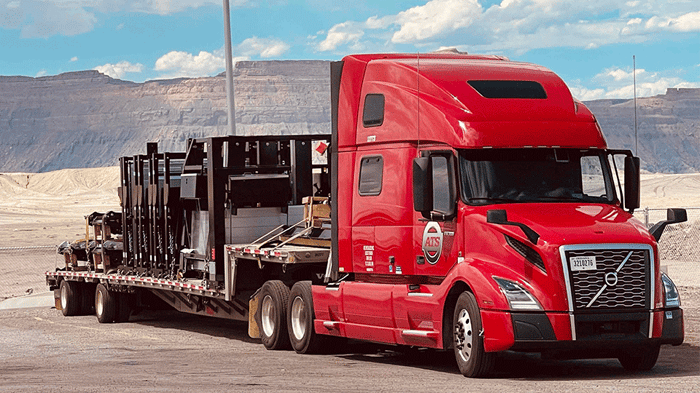 “This isn’t working.” Three dreaded words that can only mean one thing: you tried, you failed, it’s time to move on.
“This isn’t working.” Three dreaded words that can only mean one thing: you tried, you failed, it’s time to move on.
Sometimes, it’s easy to gauge a situation and take corrective action before it falls apart. At other times, this can feel impossible — as is often the case when evaluating a complex transportation network.
The success of your supply chain is too important to leave anything to chance, however.
Every day, countless people rely on you to follow through on your commitments. Unfortunately, without great carriers to rely on, you’ll struggle to achieve this end.
You deserve to work with providers that are worthy of your business; companies that value your relationship and have the resources, expertise and capabilities to meet your needs.
The best transportation providers should become an extension of your business, displaying servant leadership with each interaction.
Are these the kinds of transportation companies you work with?
If not, it may be time to move on. But how can you know when enough is, truly, enough?
Here at Anderson Trucking Service (ATS), nearly seven decades in this business have shown us how difficult it can be for shippers to decide when to cut ties with unworthy carriers. When they do, though, removing shoddy providers from their supply chain pays dividends for shippers in the form of cost savings and improved efficiency. These are things worth pursuing.
This article will help you make this important discernment by outlining the markers of bad service and helping you set a baseline for what’s acceptable.
Below we’ll cover:
6 Leading Indicators That an Issue Might Exist
Your transportation company should always create a top-of-the-line experience for your business — you’re their customer, after all. This relationship should never be burdensome or difficult to manage. Take this as a warning whenever it does.
Providing transportation services at the highest level is not easy — nobody ever claimed it was. That’s why it’s not uncommon for little issues to arise now and again, plaguing even the most experienced transportation companies.
However, self-inflicted, avoidable issues should never become the norm. And, any time the problems listed below occur in a pattern, you’ll want to re-evaluate this relationship.
Six indicators that you may have an issue to address with your provider are:
- Communication breakdowns
- Delayed response to opportunities
- Consistent price misalignment (not matching business needs/budgetary expectations)
- Not executing to performance expectations
- Consistent cargo damage/condition issues
- Poor paperwork and billing processes
Issue #1 | Communication Breakdowns
Communication is key to any successful relationship. Getting your company on the same page as its transportation providers is crucial to achieving your goals.
As such, communication barriers shouldn’t be taken lightly. You should never struggle to set expectations, convey your needs, arrange a solution or touch base with your carriers.
Your provider should always give you clear lines of communication to utilize when necessary. Whether it’s via email, a phone call or a customer portal, a good carrier will be easy to communicate with — even on short notice.
Unfortunately, in such a fast-paced industry, communication issues do happen in the transportation realm. When they do, limiting your ability to make adjustments and plans, this can be harmful to your supply chain and customers.
Keep track of communication issues as they come up. And, when you face these problems frequently, take this as a sign that your carrier is underperforming.

Issue #2 | Delayed Response to Opportunities
Offering a transportation company your business is no small thing. That’s why, when you have a shipment to move, your carriers should address this need quickly.
At the end of the day, the commitments you’ve made to customers must be fulfilled.
Anytime your transportation provider makes this harder — by lethargically responding to a service request — this is a red flag.
As their customer, your needs come first. So, when the time comes for your shipment to move, and you reach out to them for a pickup, they should provide a solution promptly.
Although it’s not unreasonable for your provider to respond within 12 hours (especially if you’ve contacted them after regular business hours), expect a much quicker response; two hours or less is the norm.
Since you’re making agreements with customers based on the understanding that your provider has your back, a 24-48 hour delay while you wait for a response is unacceptable and shouldn’t be taken lightly.
Issue #3 | Consistent Price/Budget Misalignment
For you, transporting cargo from A to B is purely an expense. Though there’s something to be said about the relationship between the price you pay and the service level you receive, you still have a budget to maintain.
The best transportation providers price to execute. Using relevant market data, these companies quote freight based on what it costs to get it moved at that exact moment.
These are the kinds of providers you want to work with. However, try as they might, some carriers can’t do this as effectively as others. Whether it’s because of their location, network of resources, financial standing or simple inexperience, many providers consistently price freight higher than others.
 While this won’t significantly impact your company in a one-off scenario, on an ongoing basis higher-than-average freight rates can quickly add up.
While this won’t significantly impact your company in a one-off scenario, on an ongoing basis higher-than-average freight rates can quickly add up.
If your transportation spend is consistently rising each period, yet your carrier is still executing well, it may be time for a conversation. Ask your provider why your rates are rising and what, if anything, you can do to save money on your freight spend going forward.
Make sure to communicate where you’d like to be budget-wise and work together to develop a strategy for getting there.
That said, when paying for transportation services becomes too large of a burden, it may be time to look elsewhere for a solution. You’ll find some carriers can price more competitively than others and it never hurts to explore your options.
Issue #4 | Not Executing to Performance Expectations
You set performance expectations with every carrier you onboard. These expectations center around their adherence to a set of key performance metrics, things like on-time pickup/delivery, tender acceptance and pricing accuracy.
In the beginning, agreements are made to hold your provider(s) accountable, ensuring their performance (or lack thereof) doesn’t affect your business and customers.
Your providers must execute to the standards you set for them, especially if they’ve agreed to do so. So, whenever you begin to see a slip in performance, be it a fall from 96 percent tender acceptance to 94 percent or from 95 percent on-time delivery to 92 percent, address these concerns head-on.
You’re relying on your provider to hold to their commitments so you can meet yours. As such, when they consistently fail to meet your expectations, this might be a sign that it’s time to move on.
Related Content: 6 Steps For Onboarding a New Transportation Provider
Issue #5 | Consistent Cargo Damage/Condition Issues
Your products are your livelihood, getting them to and from your business in good condition shouldn’t be difficult. Unfortunately, because shipping freight has so many variables (handling points, exposure to the elements, jostling during transport, etc.) sometimes freight is damaged in transit.
That said, with good transportation providers, instances of cargo damage are few and far between. These companies know exactly how to handle, secure, protect and ship freight of all kinds. And, over time, as a carrier gets more familiar with your products, cargo damage should virtually disappear from your supply chain.
So, if you experience damaged products, this could be a sign that your carrier isn’t up to snuff. Good transportation providers make sure every driver can safely and securely move their customer’s cargo.
Freight damage isn’t a by-product of shipping or something you need to accept.
Issue #6 | Poor Paperwork and Billing Processes
Every shipment needs to be documented and invoiced appropriately. Great carriers have systems in place for managing the paperwork and invoices associated with each shipment they move. This makes for a clean, smooth process for their customers, allowing them to keep organized on their end as well.
It’s not uncommon, however, for some transportation providers to do this better than others. And, instead of quickly sending out accurate invoices, some providers are sluggish at doing so.
 Organized transportation companies are well-oiled machines, with billing departments constantly churning out accurate invoices promptly. This helps their customers stay on top of each payment to avoid overdue balances month-over-month.
Organized transportation companies are well-oiled machines, with billing departments constantly churning out accurate invoices promptly. This helps their customers stay on top of each payment to avoid overdue balances month-over-month.
Dependable invoicing and documentation processes demonstrate a carrier’s in-house bandwidth. Do they have too much going on to give your account the attention it deserves? If so, it may be time to move on.
How to Know When it’s Time to Part Ways
Now you know the impact these six indicators can have on your business’ success. With this in mind, it will be easier to see and interpret these warning signs in the future.
That said, with so many other things on your plate and such a vast transportation market, actually cutting ties with an underperforming carrier can feel like more trouble than it’s worth.
You don’t want to take the time to find a new provider unless it’s absolutely necessary.
So, how can you definitively know when the time comes to change it up?
The answer is actually quite simple: Whenever one, or more, of these issues starts to affect your business, your customers and/or your internal processes, it’s time to switch providers.
Depending on your business’ threshold for disruption, exact timing will change.
That said, take a strong look at a carrier after three separate instances of communication breakdowns, delayed response to opportunities, consistent price/budget misalignment, underperformance, cargo damage problems or invoicing/documentation errors.
Once dealing with a carrier’s problems is diverting your attention away from other things, it’s time to move on.
Use This Tool to Find Great Providers!
Going forward, these insights will help you determine when it’s time to switch providers. This can be a difficult step to take but, once it’s over, your supply chain will be healthier for it.
At the end of the day, you need reliable transportation partnerships. But, with so many companies to choose from in the transportation industry, developing these relationships can be challenging.
Here at ATS, we’ve developed a tool to help you manage this process. Download this free Freight Carrier Selection Checklist today. This 30-question checklist will help you vet transportation providers in the future so you’re confident that your freight is in good hands.
Once you have a well-rounded network of reliable providers, you won’t need to worry about switching things up for a long time. Use the Freight Carrier Selection Checklist to get to this point.
Finally, if you’d like to learn more about the steps ATS takes to ensure its customers receive top-of-the-line, dependable service, check out our services page here. We’re always happy to help great companies, like yours, deliver on their customer commitments.




